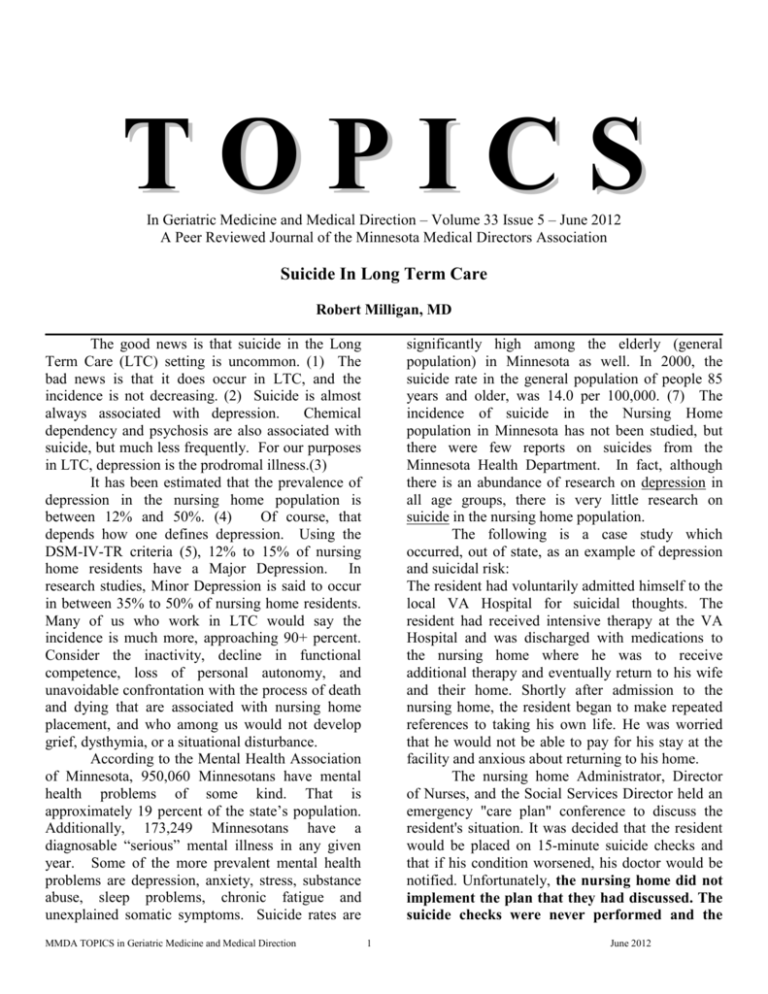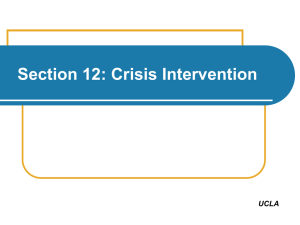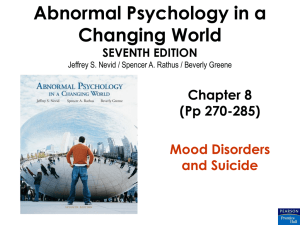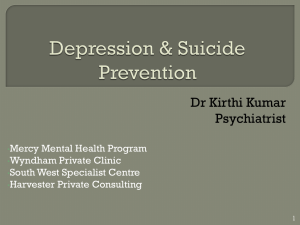
TOPICS
In Geriatric Medicine and Medical Direction – Volume 33 Issue 5 – June 2012
A Peer Reviewed Journal of the Minnesota Medical Directors Association
Suicide In Long Term Care
Robert Milligan, MD
____________
The good news is that suicide in the Long
Term Care (LTC) setting is uncommon. (1) The
bad news is that it does occur in LTC, and the
incidence is not decreasing. (2) Suicide is almost
always associated with depression.
Chemical
dependency and psychosis are also associated with
suicide, but much less frequently. For our purposes
in LTC, depression is the prodromal illness.(3)
It has been estimated that the prevalence of
depression in the nursing home population is
between 12% and 50%. (4)
Of course, that
depends how one defines depression. Using the
DSM-IV-TR criteria (5), 12% to 15% of nursing
home residents have a Major Depression. In
research studies, Minor Depression is said to occur
in between 35% to 50% of nursing home residents.
Many of us who work in LTC would say the
incidence is much more, approaching 90+ percent.
Consider the inactivity, decline in functional
competence, loss of personal autonomy, and
unavoidable confrontation with the process of death
and dying that are associated with nursing home
placement, and who among us would not develop
grief, dysthymia, or a situational disturbance.
According to the Mental Health Association
of Minnesota, 950,060 Minnesotans have mental
health problems of some kind. That is
approximately 19 percent of the state’s population.
Additionally, 173,249 Minnesotans have a
diagnosable “serious” mental illness in any given
year. Some of the more prevalent mental health
problems are depression, anxiety, stress, substance
abuse, sleep problems, chronic fatigue and
unexplained somatic symptoms. Suicide rates are
MMDA TOPICS in Geriatric Medicine and Medical Direction
________________________
significantly high among the elderly (general
population) in Minnesota as well. In 2000, the
suicide rate in the general population of people 85
years and older, was 14.0 per 100,000. (7) The
incidence of suicide in the Nursing Home
population in Minnesota has not been studied, but
there were few reports on suicides from the
Minnesota Health Department. In fact, although
there is an abundance of research on depression in
all age groups, there is very little research on
suicide in the nursing home population.
The following is a case study which
occurred, out of state, as an example of depression
and suicidal risk:
The resident had voluntarily admitted himself to the
local VA Hospital for suicidal thoughts. The
resident had received intensive therapy at the VA
Hospital and was discharged with medications to
the nursing home where he was to receive
additional therapy and eventually return to his wife
and their home. Shortly after admission to the
nursing home, the resident began to make repeated
references to taking his own life. He was worried
that he would not be able to pay for his stay at the
facility and anxious about returning to his home.
The nursing home Administrator, Director
of Nurses, and the Social Services Director held an
emergency "care plan" conference to discuss the
resident's situation. It was decided that the resident
would be placed on 15-minute suicide checks and
that if his condition worsened, his doctor would be
notified. Unfortunately, the nursing home did not
implement the plan that they had discussed. The
suicide checks were never performed and the
1
June 2012
resident's doctor was never notified. The resident
straightened his room, wrote detailed notes
regarding his last wishes, and hanged himself in the
closet of his room with his belt. He was not found
until hours later.
and three suicide attempts were identified, including
six men and two women. Deaths were the result of
drowning, hanging, or medication overdose (the
latter following a period of intentional hoarding).
Those who died ranged in age from 69 to 87 years.
Most had been NH residents for less than 6 months.
No deaths occurred in patients with severe
cognitive impairment.
I was unable to find any tracking statistics of
suicide in LTC at either the CMS (Medicare) or the
State of Minnesota Department of Health websites.
The Department of Health site did discuss the
problem, and had two case studies which resulted in
deficiencies to the respective homes. One was from
2008 (6), and the other more recently occurred in
2011.
The episode from 2008 was a gentleman
admitted to an urban nursing home February 28,
2008 from the hospital with diagnosis of CHF
(congestive heart failure) and depression being
treated with Celexa 10mg daily.
His MDS
(Minimum Data Set) and Burns Depression Scale
indicated he was, “normal, but had some
unhappiness, with no treatment usually needed.”
He had not made any negative comments, or
expressed thoughts of suicide. None of the staff or
family had any knowledge of suicidal ideation and
“it was a complete surprise.” Police and Fire
Rescue found the resident hanging from the
doorstop on top of the door by his knotted call light
cord. A suicide note was taped to his chest.
The more recent episode occurred in the Fall
of 2011. A 90 year old resident was admitted in
July of 2010 to the facility's Transitional Care Unit
(TCU) with diagnoses that included depression.
During a recent MDS assessment dated 10/2/2010,
she admitted to facility staff that she felt she was
better off dead or had had thoughts of hurting
herself 12-14 days in the last 14 days. The
investigators felt the facility social service staff did
not monitor her progress related to her depression.
The resident was found in her bed on the
TCU deceased, with a plastic bag over her head and
tied at the neck on 10/21/2010. The medical
examiner's report dated 10/27/2010 listed the
manner of death as suicide. The incident was a
surprise to the staff, as the resident had refused the
psychological consult offered, because she did not
think any further assessment or intervention was
necessary. The resident stated to staff she did not
have plans to harm herself and was making plans
Studies Regarding the Incidence of Suicide
Although, we have data describing the
incidence of depression in LTC, there are only a
few studies looking at the incidence of suicide in
LTC. One study is of interest because it is the
largest published series of nursing home suicides. It
was from Finland and although published in 2003, it
looked at suicides in the year 1987. Of 1,397
nursing home residents, during that year of data
collection, thirteen residents of nursing homes
committed suicide. Twelve were over age 60 (mean
age 76.1 +/- 5.7 years), and were included in this
study. The remaining case was age 43 with a history
of head trauma, and was excluded. (1) Nine out of
twelve were male (though 75 % of nursing home
residents are female). 8/12 died by hanging, 3/12 by
drowning, and 1/12 by shooting. 5/12 had moved
into the nursing home in the last year of living. 4/12
had reported pain; all had co-morbid mental
conditions diagnosed on Axis III of DSM. Further,
4/12 had previously attempted suicide. Nine of the
twelve were diagnosed with depression, and alcohol
abuse occurred in 3 of them. Eight of the twelve
had no lifetime history of psychiatric treatment. It
is noteworthy that 8/12 cases died by hanging,
which seems to be the most common mechanism of
suicide in the LTC facility.
In another study (2), during the period
between 1990 and 2005, there were 1,771 suicides
among NYC residents aged 60 and older.
47
occurred in LTC and 1,724 in the community.
Cases in LTC tended to be older (P<.02) but did not
differ from community cases in terms of race or sex.
Suicides in LTC were significantly less likely
(RR=0.05, P<.002) to be due to firearms and 2.49
times as likely to be due to a long fall (P<.002) as
community cases. Over the 15-year period, there
was a significant decrease in the relative rate of
suicide in community-dwelling adults (RR=0.97,
P<.001) but no change in residents of LTC
(RR=1.05, P<.17).
Closer to home, a study In Olmsted County
and surrounding communities in Minnesota (846
NH beds) looked at suicides occurring between
1981 and 1997. Five cases of completed suicide
MMDA TOPICS in Geriatric Medicine and Medical Direction
2
June 2012
for the future at an assisted living facility. The
investigators were concerned that the patient’s
physician was not informed of the depression
assessment findings.
3) Nursing home residents who have thoughts of
suicide should be referred immediately to a mental
health professional, just as one would for any age
group.
4) The resident’s physician should be notified of
any history, signs or symptoms of major depression
or voicing suicidal thoughts, for recommendations
for referral and treatment.
5) For any resident who is clearly a danger to
him/herself or to others, the police should be called
immediately. The staff should not try to talk down,
or disarm a dangerous individual. The police are
able to put a transport hold on any individual who is
dangerous to self or others.
6) LTC facilities do not have the staffing or
environment to effectively perform suicide
precautions, i.e., are unable to ensure safety for a
suicidal individual. Therefore if there is a
reasonable suspicion for suicidal risk, that resident
should be transferred immediately to the nearest
emergency room or psychiatric facility.
7) Transfer to an emergency room is something that
should be done whenever we are concerned about
suicidal risk, both from a medico-legal stand-point,
and knowing that the emergency room has quicker
access to a mental health professional than do most
Nursing Homes
8) It is okay to ask a person about suicidal thoughts,
or thoughts of harming oneself. It does not increase
a person’s risk of suicide. Instead, it gives the
individual the opportunity to talk about his/her
feelings, which is therapeutic.
9) Of course all of these strategies rely on the ability
to identify an individual at risk for suicide. We
can’t predict the future with certainty. As such it is
better to err on the conservative side and obtain a
psychological or psychiatric consult for assessment
if a suspicion is present.
Unfortunately, there is little research into
the actual interventions and their effectiveness.
Although, most physicians will order 1:1 nursing as
part of the suicide precaution, this is rarely possible
in the nursing home due to staffing limitations, and
there are no studies demonstrating its effectiveness.
The sad reality is that if a person has decided on a
plan of suicide, and that person doesn’t get timely
mental health treatment, there is a good chance that
the suicide will be successful, as identified in the
case reports above.
How can a nursing home be liable for a
resident
who
commits
suicide?
Taken from Law Office of Robert H. Gregory
website, there are Three Biggies:
• Failing to adequately assess the mental
health of the resident upon admission.
• Failing to monitor a resident who is on antidepressants or psychotropic medications
when there is a substantial increased risk of
suicidal ideations associated with many of
these medications.
• Failing to advise the resident's treating
physician of a substantial change in the
resident's mental health.
These are the items which are most cited by
Investigators. They tend to fall under Federal
Regulation F-224 regarding “neglect”.
The
interpretive guideline states, “Neglect” means
failure to provide goods and services necessary to
avoid physical harm, mental anguish, or mental
illness” (8).
What can we do?
As we may see from these case studies, the
diagnosis of depression almost always preceded
the suicide. We have to keep up vigilance with any
person with a history of depression. An admission
to a LTC facility is traumatic to an individual, with
the change in health and independence. It is a
major loss. We cannot assume, because a person is
ill or elderly, that that person is safe, or incapable of
taking their own life.
The following suggestions are from various
nursing home policies, the Department of Health,
personal experience as a medical Director, and
policies regarding suicide precautions from Allina.
In the LTC setting, we should consider:
1) Nursing home residents should be screened for
depression within 2 weeks after they are admitted to
the nursing home (the PHQ-9 in the MDS is one
tool).
2) Nursing home residents should be screened for
depression every 6 months.
MMDA TOPICS in Geriatric Medicine and Medical Direction
3
June 2012
a plan, and remember the steps to carry it out. This
view was supported by several authors.
Bibliography
(1) Suominen K, H. M. (December 2003). Nursing
home suicides – a psychological autopsy study.
International Journal of Geriatric Psychiatry, 10951101.
(2) Briana Mezuk PhD, e. a. (November 2008).
Suicide in Older Adults in Long-Term Care: 1990
to 2005. Journal of the American Geriatrics
Society, 2107–2111.
(3) All About Depression.com. (2012, February 8).
http://www.allaboutdepression.com/gen_04.html
(4) Reji Attupurath, MD, Reeja C. Menon, MD,
Sreenath V. Nair, MD, Sunanda Muralee, MD, and
Rajesh R. Tampi, MD, MS. (December 10, 2008).
Annals of Long Term Care,
(5) Diagnostic Criteria from DSM-IV-TR,
American Psychiatric Association, 2000
(6)
http://www.health.state.mn.us/divs/fpc/directory/sur
veyapp/ohfcfindings/h5187035.pdf
(7) Mental Health and Primary Care In Rural
Minnesota, Office of Rural Health and Primary
Care, Minnesota Department of Health, October,
2003.
(8) State Operations Manual, Appendix PP Guidance to Surveyors for Long Term Care
Facilities, (Rev. 70, 01-07-11
Summary and Points of Emphasis
Suicide is preceded by mental illness, i.e.,
chemical dependency, psychosis, or other mental
illness, and most often by depression. Although
LTC residents frequently have depression, suicide is
infrequent, occurring in the United States at a rate
of 0.4 suicides/1000 residents/year, even less
frequently in Minnesota, with only two documented
episodes of suicide occurring in the last three years
(2). Suicide cannot always be prevented, but we
need to be vigilant and keep a high index of
suspicion of suicidal risk for anyone with
depression. Any residents verbalizing thoughts of
harming themselves or others should be taken
seriously, and the physician notified.
The
physician, nurse, social worker, and DON then need
to decide whether there is significant risk, in which
case the police should be called, and the patient
transferred
for
psychological/psychiatric
assessment. If the risk is low after talking to the
individual, a psychological assessment may be
scheduled. If a person is armed, call the police.
The staff should not try to disarm an
individual (like a well-meaning nurse tried at one of
my facilities one time, and suffered a laceration as a
result). It is not only okay to ask an individual
about suicide thoughts, and whether they have a
specific plan, but important to ask. Listening to and
acknowledging a resident's feelings can be most
therapeutic.
Finally, here is a positive point. People with
significant dementia are at low risk for suicide.
They often have depression, and sometimes will
express suicidal ideation and “wishing I was dead.”
The low incidence of acting on those feelings is
attributed to the demented person’s inability to form
MMDA TOPICS in Geriatric Medicine and Medical Direction
About the Author
Bob Milligan, MD, MS, FAAFP, is a past president
of MMDA. He is part of a group practice in the
northwestern suburbs of the Twin Cities, and is the
Medical Director of two facilities, The Annandale
Care Center in Annandale, MN, and the Park View
Care Center in Buffalo, MN.
4
June 2012
President's Letter
Summer is finally here and Minnesota shines so I will keep this brief...
Last year MMDA held a strategic planning session to set long term goals including increasing networking
among local organizations as well as other AMDA chapters. I have been in contact with the Illinois
chapter and together we are planning the first Midwest AMDA Conference September 28-30, 2012 in
Chicago. Details are still being worked out. Please consider attending to support this new endeavor.
Contact me directly for details. In an effort to reach out locally I will also be attending the Minnesota
Leadership Council on Aging this month.
Update from AMDA- Significant issue continues to be request for the state chapters to encourage AMA
membership. AMDA is presenting our case at the AMA meeting June 18, 2012 to defend our
representation. AMDA is expected to have 1,000 members in AMA and currently we have around 880. It
is critical when you pay the dues that you designate your affiliation with AMDA. AMDA is well aware of
the controversy regarding AMA not always representing Primary Care fairly however, it is felt this is
improving and on balance the benefit we get is significant.
Core Curriculum for Medical Director Certification course will be July 21-27, 2012 in Baltimore,
Maryland. You can split the session in two parts and you have five years to complete the course to be
eligible for certification. I strongly support this course for educational as well as leadership purposes.
If you are looking for some leisure reading by the pool I found this article to be of interest. It finds
feeding tubes are not associated with prevention or improved healing of a pressure ulcer. Rather, findings
suggest that the use of PEG tube is associated with increased risk of pressure ulcers among NH residents
with advanced cognitive impairment.
http://archinte.jamanetwork.com/article.aspx?articleid=1151419
Until next time,
Christine Duncan MD
President,
Minnesota Medical Directors Association
POCKET CODER FOR LONG-TERM CARE
AVAILABLE
A laminated pocket-sized guide for coding diagnoses commonly
encountered by LTC providers is now available free of charge to MMDA
members.
Contact David E. Pautz, MD, FACP at 651-662-1863 or 1-888-878-0139
or
David_E_Pautz@bluecrossmn.com with the number of guides needed.
MMDA TOPICS in Geriatric Medicine and Medical Direction
5
June 2012
Minnesota Medical Directors Association
P. O. Box 24475
Minneapolis, MN 55424
Phone:952-929-9398
Fax: 952-929-4363
Website:
www.minnesotageriatrics.org
Executive Director: Rosemary Lobeck
Editor: C. Dwight Townes, M.D.
E-mail: rlobeck@mnmeddir.org
Topics in Geriatric Medicine and
Medical Direction is produced and
Published bimonthly by the Minnesota
Medical Directors Association.
Inside
Suicide in Long Term Care
President’s Letter
Topics in Geriatric Medicine and Medical Direction, the
peer reviewed bimonthly publication of the Minnesota
Medical Directors Association, is committed to publishing
quality manuscripts representing scholarly inquiry into all
areas of geriatrics and long term care medical direction
and practice. We encourage submissions of geriatric and
long term care research, best practices, reviews of
literature and essays.
Page 1
Page 5
Save the Date:
MMDA Fall Conference:
October 25-26, 2011
Marriott Minnetonka Hotel, Minnetonka
Manuscripts should be emailed to rlobeck@mnmeddir.org
and cdwighttownes@hotmail.com. The first page should
include the title and a 50 to 60 word abstract. Manuscripts
should range around 1800 to 3000 words.
Review Policy: Manuscripts will be reviewed by at least
two members of the review board whose evaluations will
provide a basis for the publication decision. We are
committed to a rapid review process.
All rights reserved.
Copyright Minnesota Medical
Directors Association. Topics may be copied only with
prior permission. Contact MMDA at 952-929-9398.
MMDA TOPICS in Geriatric Medicine and Medical Direction
6
June 2012










